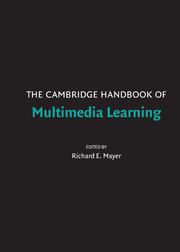Book contents
- Frontmatter
- Contents
- Preface
- Contributors
- 1 Introduction to Multimedia Learning
- PART I THEORETICAL FOUNDATIONS
- PART II BASIC PRINCIPLES OF MULTIMEDIA LEARNING
- 6 Five Common but Questionable Principles of Multimedia Learning
- 7 The Multimedia Principle
- 8 The Split-Attention Principle in Multimedia Learning
- 9 The Modality Principle in Multimedia Learning
- 10 The Redundancy Principle in Multimedia Learning
- 11 Principles for Managing Essential Processing in Multimedia Learning : Segmenting, Pretraining, and Modality Principles
- 12 Principles for Reducing Extraneous Processing in Multimedia Learning : Coherence, Signaling, Redundancy, Spatial Contiguity, and Temporal Contiguity Principles
- 13 Principles of Multimedia Learning Based on Social Cues : Personalization, Voice, and Image Principles
- PART III ADVANCED PRINCIPLES OF MULTIMEDIA LEARNING
- PART IV MULTIMEDIA LEARNING IN CONTENT AREAS
- PART V MULTIMEDIA LEARNING IN ADVANCED COMPUTER-BASED CONTEXTS
- Author Index
- Subject Index
- References
6 - Five Common but Questionable Principles of Multimedia Learning
Published online by Cambridge University Press: 05 June 2012
- Frontmatter
- Contents
- Preface
- Contributors
- 1 Introduction to Multimedia Learning
- PART I THEORETICAL FOUNDATIONS
- PART II BASIC PRINCIPLES OF MULTIMEDIA LEARNING
- 6 Five Common but Questionable Principles of Multimedia Learning
- 7 The Multimedia Principle
- 8 The Split-Attention Principle in Multimedia Learning
- 9 The Modality Principle in Multimedia Learning
- 10 The Redundancy Principle in Multimedia Learning
- 11 Principles for Managing Essential Processing in Multimedia Learning : Segmenting, Pretraining, and Modality Principles
- 12 Principles for Reducing Extraneous Processing in Multimedia Learning : Coherence, Signaling, Redundancy, Spatial Contiguity, and Temporal Contiguity Principles
- 13 Principles of Multimedia Learning Based on Social Cues : Personalization, Voice, and Image Principles
- PART III ADVANCED PRINCIPLES OF MULTIMEDIA LEARNING
- PART IV MULTIMEDIA LEARNING IN CONTENT AREAS
- PART V MULTIMEDIA LEARNING IN ADVANCED COMPUTER-BASED CONTEXTS
- Author Index
- Subject Index
- References
Summary
Principle:A basic generalization that is accepted as true and that can be used as a basis for reasoning or conduct.
OneLook.com DictionaryAbstract
This chapter describes five commonly held principles about multimedia learning that are not supported by research and suggests alternative generalizations that are more firmly based on existing studies. The questionable beliefs include the expectations that multimedia instruction: (1) yields more learning than live instruction or older media; (2) is more motivating than other instructional delivery options; (3) provides animated pedagogical agents that aid learning; (4) accommodates different learning styles and so maximizes learning for more students; and (5) facilitates student-managed constructivist and discovery approaches that are beneficial to learning.
Introduction
Multimedia instruction is one of the current examples of a new area of instructional research and practice that has generated a considerable amount of excitement. Like other new areas, its early advocates begin with a set of assumptions about the learning and access problems it will solve and the opportunities it affords (see, e.g., a report by the American Society for Training and Development, 2001). The goal of this chapter is to examine the early expectations about multimedia benefits that seem so intuitively correct that advocates may not have carefully examined research evidence for them. If these implicit assumptions are incorrect we may unintentionally be using them as the basis for designing multimedia instruction that does not support learning or enhance motivation.
- Type
- Chapter
- Information
- The Cambridge Handbook of Multimedia Learning , pp. 97 - 116Publisher: Cambridge University PressPrint publication year: 2005
References
- 58
- Cited by

